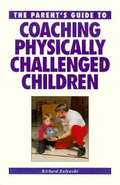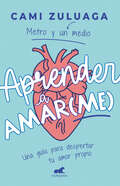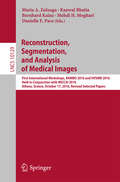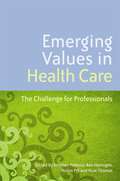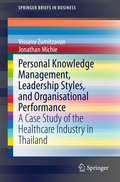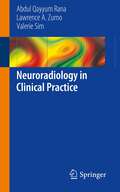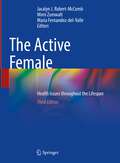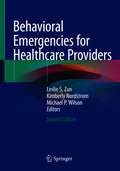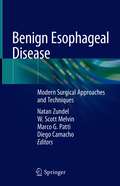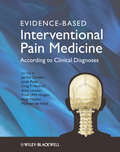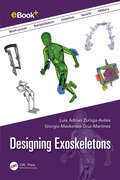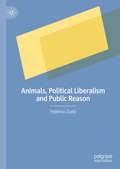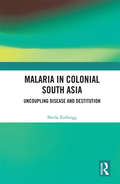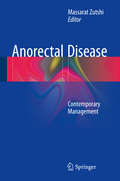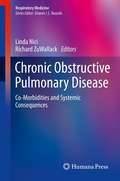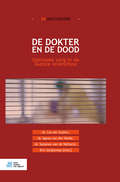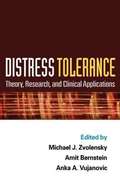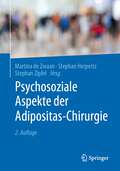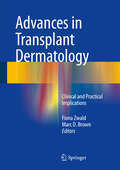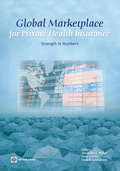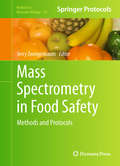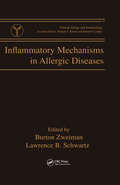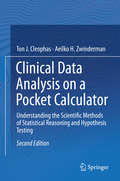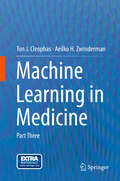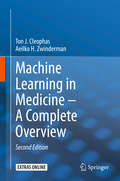- Table View
- List View
The Parents Guide to Coaching Physically Challenged Children
by Richard ZulewskiHandbooks in The Better Way Coaching Kids series serve as the perfect step-by-step introductory primers for parents and coaches. Written in an easy, conversational style, these books cover all the basic skill-building techniques, rules of the games, proper equipment and first aid. These guides focus on team spirit, the importance of fair play and overall fun. Special attention is paid to developing a child's confidence and self-esteem, -- all important keys to success.
Aprender a amar(me)
by Camila Zuluaga"El amor propio nos enseña que el dolor no es una opción" CAMI ZULUAGA, influenciadora colombiana, tuvo un episodio depresivo muy fuerte y descubrió que también sufre de codependencia, un trastorno que la hace tener relaciones tóxicas. En este inspirador libro nos cuenta su proceso de rehabilitación, y con ejercicios, consejos y actividades, nos comparte las herramientas que la ayudaron a salir adelante. Aprender a amar(me) nos va a enseñar a tener relaciones amorosas y saludables, empezando por la más importante: la que tenemos con nosotros mismos
Reconstruction, Segmentation, and Analysis of Medical Images
by Maria A. Zuluaga Kanwal Bhatia Bernhard Kainz Mehdi H. Moghari Danielle F. PaceThis book constitutes the refereed proceedings of two workshops held at the 19th International Conference on Medical Image Computing and Computer-Assisted Intervention, MICCAI 2016, in Athens, Greece, in October 2016: the First International Workshop on Reconstruction and Analysis of Moving Body Organs, RAMBO 2016, and the First International Workshop on Whole-Heart and Great Vessel Segmentation from 3D Cardiovascular MRI in Congenital Heart Disease, HVSMR 2016. The 17 revised regular papers presented in this book were carefully reviewed and selected from a total of 21 submissions. The papers cover following topics: Registration; Reconstruction; Deep learning for heart segmentation; Discrete optimization and probabilistic intensity modeling; Atlas-based strategies; Random forests.
Emerging Values in Health Care: The Challenge for Professionals
by Paquita De Zulueta David Badcott Chris Swift Srikant Sarangi Bronwen Davies Paul Ballard Andrew Edgar Chrissie Hockley Stephen Pattison Alan Nathan Brian Hurwitz Julia Mckeown Kieran Sweeney Derek Sellman Lynn Knight Moira Dumma Heather Skirton Huw Thomas Roisin Pill Ben HanniganProfessional values in healthcare are in a state of constant and increasingly rapid change. While all professions now emphasise teamwork and collegiality in practice, fewer are inclined to consider shared or differing values across professions. This interdisciplinary volume explains how health care professions and their values have changed over the last forty years, charting where they have come from, where they are now, and how they might develop in the future. There is coverage of a wide range of different professions within healthcare, from GPs, mental health nurses, adult nurses and pharmacists, to NHS managers and chaplains. Chapters are followed by critical responses from senior healthcare practitioners. This original and insightful book will be a valuable resource for academics, researchers, senior healthcare professionals and healthcare managers.
Personal Knowledge Management, Leadership Styles, and Organisational Performance
by Vissanu Zumitzavan Jonathan MichieThis book presents unique management perspectives from Thailand's Healthcare Industry. It focuses on the areas of Personal Knowledge Management, Leadership Styles and Organisational Performance. The book highlights the various business challenges that organisations face in the context of globalisation, which itself has produced new opportunities and difficulties alike. In addition, it also elaborates on how even large organisations with strong histories can no longer compete unless they are willing to adapt to changing conditions. Demonstrating how transferring and encouraging knowledge within an organisation can generate approaches that promote its continuing success, the book mainly focuses on the perspective of the Resource Based View, a broadly recognised method for maintaining the competitive advantages of an organisation. It also stresses the importance of making the most use of organisational resources. The book offers a valuable reference work, not only for practitioners and academic researchers in the fields of Business & Management but also for students taking Leadership Management, Organisational Learning and Organisational Performance Appraisal courses, serving as a sourcebook for the principles of successful management.
Neuroradiology in Clinical Practice
by Lawrence A. Zumo Abdul Qayyum Rana Valerie SimThis quick reference guide for medical students and residents presents over sixty clinical case studies of major neurological conditions and their associated neuroimaging characteristics. A primer on the fundamental physics which underlie neuroimaging techniques is also provided. The content is organized by pathology type and the structure of every topic is similar to help the reader develop his or her thinking process in a stepwise fashion and to provide a rational approach to imaging interpretation. Neuroradiology in Clinical Practice is aimed at medical students and residents doing their rotations in neurology, internal medicine, emergency medicine, and family medicine, but will also be useful for allied health professionals, nurse practitioners, physician assistants and other primary medical care providers.
The Active Female: Health Issues throughout the Lifespan
by Mimi Zumwalt Jacalyn J. Robert-McComb Maria Fernandez-del-ValleNow in a revised and expanded third edition, the aims of The Active Female are threefold: first, to increase the awareness of wellness and fitness issues for active females and their family members; second, to provide an avenue for medical practitioners, allied health professionals, health educators/providers, and certified individuals in sports medicine/athletics to gain critical, updated knowledge of a field specific to active females; and third, to introduce the concept of obesity as a growing health concern even for normal weight individuals. Part I of the book offers a foundation for understanding the interrelationships between female physiology, body image and other psychological issues, the female reproductive cycle, and the musculoskeletal anatomy and physiology of females that makes their health risks and concerns unique. In Part II, the concepts of eating disorders from a global perspective and the health disparities and inequities in women’s health are discussed in detail. Part III describes the prevention and management of common musculoskeletal injuries in active females across the lifespan, including the management of osteoporosis. Appropriate exercise and nutritional guidelines and recommendations for active females are discussed in detail in Parts IV and V. Part VI is a new addition to the book and highlights the obesity epidemic and co-morbid diseases associated with obesity even for normal weight obese individuals. Each chapter is bookended by clear learning objectives and review questions for additional pedagogical appeal. An invaluable addition to the literature, The Active Female: Health Issues throughout the Lifespan, 3e will be of great interest to all clinicians and allied health care professionals concerned with women’s health and related issues, from sports medicine and family practitioners to endocrinologists, gynecologists and orthopedic surgeons.
Behavioral Emergencies for Healthcare Providers
by Leslie S. Zun Kimberly Nordstrom Michael P. WilsonThis fully updated second edition focuses on mental illness, both globally and in terms of specific mental-health-related visits encountered in emergency department settings, and provides practical input from physicians experienced with adult emergency psychiatric patients. It covers the pre-hospital setting and advising on evidence-based practice; from collaborating with psychiatric colleagues to establishing a psychiatric service in your emergency department. Potential dilemmas when treating pregnant, geriatric or homeless patients with mental illness are discussed in detail, along with the more challenging behavioral diagnoses such as substance abuse, factitious and personality disorders, delirium, dementia, and PTSD. The new edition of Behavioral Emergencies for Healthcare Providers will be an invaluable resource for psychiatrists, psychologists, psychiatric and emergency department nurses, trainee and experienced emergency physicians, and other mental health workers.
Benign Esophageal Disease: Modern Surgical Approaches and Techniques
by Natan Zundel W. Scott Melvin Marco G. Patti Diego CamachoThis book aims to review all of the literature, including landmark papers and the most current published data, in regard to the management of non-malignant foregut diseases. A number of surgeons publish and focus in malignant diseases of the esophagus, but this text emphasizes the benign ones, their problems and how to face them with the new available resources and technology. This book describes the different diagnostic tools available, as well as the different therapies for the management of gastroesophageal reflux disease (GERD) and its potential complications like Barret’s or strictures, and the associated anatomical abnormalities such as hiatal hernia or short esophagus, and more. Motility disorders of the esophagus, esophageal diverticula and perforations are also discussed. Different devices and approaches can be used to treat these diseases and they are covered and explained in different chapters of the book. Written by experts in the field, Benign Esophageal Disease provides surgeons and physicians with a concise and comprehensive summary of the current state of the field and will help guide patient management.
Evidence-based Interventional Pain Practice
by Jan Van Zundert Maarten Van Kleef Frank Huygen Craig Hartrick Nagy Mekhail Jacob Patijn Arno LatasterUnrelieved chronic pain is a worldwide epidemicChronic pain has been subject to multiple international initiatives through the World Health Organization. Interventional Pain Medicine, use of minimally invasive techniques to relieve pain, is the best approach when simpler measures such as physical therapy or medications fail. However, these procedures can be associated with significant risk and expense. Establishing uniformity in diagnostic criteria and procedural performance can reduce both morbidity and unnecessary procedures, and hence healthcare expenditures.While other texts explain how to perform these procedures, little focus has been given to diagnostic considerations: if and when these procedures should be performed. Evidence-based Interventional Pain Practice uniquely focuses on how the establishment of an accurate and specific diagnosis relates to the effectiveness of the interventions. It provides the evidence for the use of interventional pain techniques across all areas of chronic pain including:* Head, neck and shoulder pain * Spinal pain * Pain in the joints and extremities* Complex Regional Pain Syndrome* Phantom painEvidence-based Interventional Pain Practice provides essential knowledge for anyone who uses, or intends to use, interventional pain techniques.
Designing Exoskeletons
by Luis Adrian Zuñiga-Aviles Giorgio Mackenzie Cruz-MartinezDesigning Exoskeletons focuses on developing exoskeletons, following the lifecycle of an exoskeleton from design to manufacture. It demonstrates how modern technologies can be used at every stage of the process, such as design methodologies, CAD/CAE/CAM software, rapid prototyping, test benches, materials, heat and surface treatments, and manufacturing processes. Several case studies are presented to provide detailed considerations on developing specific topics. Exoskeletons are designed to provide work-power, rehabilitation, and assistive training to sports and military applications. Beginning with a review of the history of exoskeletons from ancient to modern times, the book builds on this by mapping out recent innovations and state-of-the-art technologies that utilize advanced exoskeleton design. Presenting a comprehensive guide to computer design tools used by bioengineers, the book demonstrates the capabilities of modern software at all stages of the process, looking at computer-aided design, manufacturing, and engineering. It also details the materials used to create exoskeletons, notably steels, engineering polymers, composites, and emerging materials. Manufacturing processes, both conventional and unconventional are discussed—for example, casting, powder metallurgy, additive manufacturing, and heat and surface treatments. This book is essential reading for those in the field of exoskeletons, such as designers, workers in research and development, engineering and design students, and those interested in robotics applied to medical devices.
Animals, Political Liberalism and Public Reason
by Federico ZuoloThis book explores the problem of disagreement concerning the treatment of animals in a liberal society. Current laws include an unprecedented concern for animal welfare, yet disagreement remains pervasive. This issue has so far been neglected both in political philosophy and animal ethics. Although starting from disagreement has been the hallmark of many politically liberal theories, none have been devoted to the treatment of animals, and conversely, most theories in animal ethics do not take the disagreement on this issue seriously. Bridging this divide with a change of perspective, Zuolo argues that we should begin from the disagreement on the moral status of animals and the treatment we owe them. Reconstructing the epistemic nature of disagreement about animals, Zuolo proposes a novel form of public justification to find principles acceptable to all. By setting out a unified framework which honours the liberal principles of respect for diversity, a robust liberal political theory capable of dealing with diverse forms of disagreement, and even some forms of radical dissent, is achieved.
Malaria in Colonial South Asia: Uncoupling Disease and Destitution
by Sheila ZurbriggThis book highlights the role of acute hunger in malaria lethality in colonial South Asia and investigates how this understanding came to be lost in modern medical, epidemic, and historiographic thought. Using the case studies of colonial Punjab, Sri Lanka, and Bengal, it traces the loss of fundamental concepts and language of hunger in the inter-war period with the reductive application of the new specialisms of nutritional science and immunology, and a parallel loss of the distinction between infection (transmission) and morbid disease. The study locates the final demise of the ‘Human Factor’ (hunger) in malaria history within pre- and early post-WW2 international health institutions – the International Health Division of the Rockefeller Foundation and the nascent WHO’s Expert Committee on Malaria. It examines the implications of this epistemic shift for interpreting South Asian health history, and reclaims a broader understanding of common endemic infection (endemiology) as a prime driver, in the context of subsistence precarity, of epidemic mortality history and demographic change. This book will be useful to scholars and researchers of public health, social medicine and social epidemiology, imperial history, epidemic and demographic history, history of medicine, medical sociology, and sociology.
Anorectal Disease: Contemporary Management
by Massarat ZutshiThis book provides a concise yet comprehensive summary of the current status of the field that guides patient management and stimulate investigative efforts. It is an easy reference for day-to-day anorectal pathology. The text reviews new testing procedures for anorectal diseases and provides new treatment options about anorectal disease both benign and malignant. All chapters are written by experts in their fields and include the most up-to-date scientific and clinical information. The text includes highly practical presentations of typical patients seen in the clinical practice of proctology in the form of case presentations with expert analysis and commentary. Example cases would include common but challenging cases such as an anal tumor, chronic anal pain and anal discharge. Anorectal Disease: Contemporary Management is a comprehensive, state-of-the-art review of this field and serves as a valuable resource for residents, clinicians, surgeons and researchers with an interest anorectal disease.
Chronic Obstructive Pulmonary Disease: Co-Morbidities and Systemic Consequences (Respiratory Medicine)
by Richard Zuwallack Linda NiciChronic Obstructive Pulmonary Disease (COPD) is a major cause of morbidity and mortality worldwide. By 2020, COPD is expected to be the fifth leading cause of disability and the third leading cause of death. COPD is associated with significant co-morbid illnesses including cardiovascular disease, pulmonary vascular disease, osteoporosis, depression and thoracic malignancies. In addition, COPD patients often have systemic manifestations of their disease, including peripheral muscle dysfunction, decreased activity levels and nutritional abnormalities, all of which contribute to poor functional status, decreased quality of life and increased health care utilization. Lack of recognition and understanding of the complex interactions of these common co-morbid conditions and systemic effects often contributes to sub-optimal care for patients with COPD. Comprehensive in covering the range of co-morbidities that often accompany COPD, Chronic Obstructive Pulmonary Disease: Co-Morbidities and Systemic Consequences provides a concise, evidence-based review of the problem and its systemic manifestations. All physicians interested in this growing disorder - from subspecialists to primary care providers -will find in this timely and informative title the practical, state-of-the art approaches needed to provide targeted, integrated care for patients with COPD.
De dokter en de dood: Optimale zorg in de laatste levensfase
by Lia Zuylen Agnes Heide Suzanne Vathorst Eric GeijtemanIedereen kent het ongenuanceerde verhaal: dokters zijn opgeleid en gemotiveerd om mensen beter te maken. Maar betekent dat dan automatisch ook dat zulke professionals hun focus verliezen bij pati#65533;nten met een infauste prognose? Dokters kunnen zich juist ook in de laatste levensfase buitengewoon verdienstelijk maken. Een complicatie daarbij is wel dat de geneeskunde-opleiding tot op de huidige dag tekort schiet in het overdragen van kennis over (be)handelen zonder curatieve intentie. Mogelijk dat prioriteiten in een overvolle doktersdag daarom wel eens in het voordeel uitvallen van pati#65533;nten met een redelijke prognose. Dit boek biedt een praktisch houvast voor artsen en andere zorgprofessionals om optimale omstandigheden te cre#65533;ren voor pati#65533;nten in tijdnood. 47 Vakgenoten bewijzen in dit boek dat optimale zorg haalbaar is in de hectische praktijk van alledag. Elk hoofdstuk start met een herkenbare casus. Dan volgt een breder getrokken beschouwing over de geschetste problematiek. Een paragraaf met praktische conclusies completeert het geheel steeds. Aldus komen - soms hoofdbrekende - thema's aan bod: Wat is 'op tijd' vertellen? Hoe gaat een arts om met een terminale pati#65533;nt die hoop houdt? Kunnen alle betrokken behandelaars alle relevante gegevens kennen? Is palliatieve sedatie in sommige gevallen geen sluitroute voor euthanasie? waar ligt de grens tussen goed behandelen en te lang doorbehandelen? Maar ook het contact met de familie komt aan de orde. Evenals de wenselijke zorg om de zorgverlener zelf, die immers per definitie vaak moet omgaan met het lijden van pati#65533;nten en hun omgeving. "Er is volop discussie gaande over de vraag of mensen die 'klaar' zijn met leven geholpen zouden kunnen worden binnen de euthanasiewet. De uitkomst van die discussie kan de grenzen verschuiven, mede afhankelijk van wat de beroepsgroep van artsen tot haar taak en domein rekent. "
Distress Tolerance
by Michael Zvolensky Amit BernsteinThis state-of-the-art volume synthesizes the growing body of knowledge on the role of distress tolerance the ability to withstand aversive internal states such as negative emotions and uncomfortable bodily sensations in psychopathology. Prominent contributors describe how the construct has been conceptualized and measured and examine its links to a range of specific psychological disorders. Exemplary treatment approaches that target distress tolerance are reviewed. Featuring compelling clinical illustrations, the book highlights implications of the research for better understanding how psychological problems develop and how to assess and treat them effectively.
Psychosoziale Aspekte der Adipositas-Chirurgie
by Martina De Zwaan Stephan Herpertz Stephan ZipfelDas Buch soll einen ersten Überblick über die psychotherapeutische Begleitung von Patienten vor und nach bariatrischen chirurgischen Eingriffen geben. Es richtet sich an die therapeutischen Teams, die mit Adipositaspatienten vor und nach der Operation arbeiten, soll aber auch Chirurgen für das Thema sensibilisieren. Durch die zunehmende Zahl an entsprechenden Operationen steigt die Notwendigkeit, diese Patienten während des gesamten Prozesses zu begleiten.
Advances in Transplant Dermatology: Clinical and Practical Implications
by Fiona Zwald Marc D. BrownThis book provides an informative update on scientific advances relating to transplant dermatology that may be applicable to clinical practice. Commentary is provided on the emerging role of viruses in transplant dermatology, the management of skin disease secondary to transplant medication, sunscreen use in transplant recipients, the role of revision of immunosuppression, and advances in photodynamic therapy. The latest staging and management criteria for high-risk squamous cell carcinoma and the implications for clinical practice are then analyzed. Finally, the management of other cutaneous malignancies is discussed, covering malignant melanoma, Merkel cell carcinoma, and rarer tumors that also behave aggressively and require special consideration in solid organ transplant patients. Each particular advance is addressed in an individual chapter by leaders in the field. The book both expands current knowledge and complements previous textbooks on the subject.
Global Marketplace for Private Health Insurance: Strength in Numbers
by Peter Zweifel Onno P. Schellekens Alexander S. PrekerFinancial protection against the cost of illness and inclusion of vulnerable groups - will require better mobilization and use of private means. Private voluntary health insurance already plays an important role in mobilizing additional resources to the health sector and protecting against the catastrophic cost of illness in some countries. This review explores the context under which private voluntary health insurance could contribute to an improvement in the sustainability of the health sector and financial protection in other countries.
Mass Spectrometry in Food Safety
by Jerry ZweigenbaumAs a key component of human survival, a safe and sufficient food supply is essential for a healthy and productive population throughout the world, so assurance that the food supply is clean and free of harmful substances is a global concern. In Mass Spectrometry in Food Safety: Methods and Protocols, experts in the field provide context to the subject through reviews of regulations in various countries, the current state-of-the art, and specific, detailed scientific methods being employed today. The volume thoroughly covers the key areas in food safety, such as detection of low level chemical residues, pesticide analysis aided by chromatographic techniques, and the revealing of mycotoxins and chemical contaminants from packaging materials. Written in the highly successful Methods in Molecular BiologyTM series format, method chapters contain introductions to their respective topics, lists of the necessary materials and reagents, step-by-step, readily reproducible laboratory protocols, and tips on troubleshooting and avoiding known pitfalls. Pertinent and cutting-edge, Mass Spectrometry in Food Safety: Methods and Protocols serves researchers with both understanding and appreciation for the contribution of mass spectrometry and its vital application to food testing and food safety.
Inflammatory Mechanisms in Allergic Diseases (Clinical Allergy And Immunology Ser. #Vol. 16)
by Burton Zweiman Lawrence B. SchwartzContains patterns of allergic reactivity for disorders such as asthma, atopic dermatitis, urticaria, and anaphylaxis. Written by leading experts in the field, Inflammatory Mechanisms in Allergic Diseases covers non-anaphylactic drug disorders; synthesis and formation of IgE antibodies; new treatments using allergenic peptides, immunostimulatory oligonucleotides, and pharmacogenomics;recent advances targeting effector mechanisms; hypersensitivity reactions to drugs and more! With over 3100 references, tables, drawings, and micrographs, Inflammatory Mechanisms in Allergic Diseases is an essential reference for allergists, pulmonologists, immunologists, dermatologists, ophthalmologists, otolaryngologists, internists, pediatricians, family practitioners, and medical students in these disciplines.
Clinical Data Analysis on a Pocket Calculator: Understanding the Scientific Methods of Statistical Reasoning and Hypothesis Testing (SpringerBriefs in Statistics #0)
by Aeilko H. Zwinderman Ton J. CleophasInmedical and health care the scientific method is little used, and statisticalsoftware programs are experienced as black box programs producing lots ofp-values, but little answers to scientific questions. The pocket calculatoranalyses appears to be, particularly, appreciated, because they enable medicaland health professionals and students for the first time to understand thescientific methods of statistical reasoning and hypothesis testing. So much so,that it can start something like a new dimension in their professional world. Inaddition, anumber of statistical methods like power calculations and required sample sizecalculations can be performed more easily on a pocket calculator, than using asoftware program. Also, there are some specific advantages of thepocket calculator method. You better understand what you are doing. The pocketcalculator works faster, because far less steps have to be taken, averages canbe used. The current nonmathematical book is complementary to thenonmathematical "SPSS for Starters and 2nd Levelers" (Springer HeidelbergGermany 2015, from the same authors), and can very well be used as its dailycompanion.
Machine Learning in Medicine
by Aeilko H. Zwinderman Ton J. CleophasMachine learning is a novel discipline concerned with the analysis of large and multiple variables data. It involves computationally intensive methods, like factor analysis, cluster analysis, and discriminant analysis. It is currently mainly the domain of computer scientists, and is already commonly used in social sciences, marketing research, operational research and applied sciences. It is virtually unused in clinical research. This is probably due to the traditional belief of clinicians in clinical trials where multiple variables are equally balanced by the randomization process and are not further taken into account. In contrast, modern computer data files often involve hundreds of variables like genes and other laboratory values, and computationally intensive methods are required. This book was written as a hand-hold presentation accessible to clinicians, and as a must-read publication for those new to the methods.
Machine Learning in Medicine – A Complete Overview
by Aeilko H. Zwinderman Ton J. CleophasAdequate health and health care is no longer possible without proper data supervision from modern machine learning methodologies like cluster models, neural networks, and other data mining methodologies. The current book is the first publication of a complete overview of machine learning methodologies for the medical and health sector, and it was written as a training companion, and as a must-read, not only for physicians and students, but also for any one involved in the process and progress of health and health care.In this second edition the authors have removed the textual errors from the first edition. Also, the improved tables from the first edition, have been replaced with the original tables from the software programs as applied. This is, because, unlike the former, the latter were without error, and readers were better familiar with them.The main purpose of the first edition was, to provide stepwise analyses of the novel methods from data examples, but background information and clinical relevance information may have been somewhat lacking. Therefore, each chapter now contains a section entitled "Background Information".Machine learning may be more informative, and may provide better sensitivity of testing than traditional analytic methods may do. In the second edition a place has been given for the use of machine learning not only to the analysis of observational clinical data, but also to that of controlled clinical trials.Unlike the first edition, the second edition has drawings in full color providing a helpful extra dimension to the data analysis.Several machine learning methodologies not yet covered in the first edition, but increasingly important today, have been included in this updated edition, for example, negative binomial and Poisson regressions, sparse canonical analysis, Firth's bias adjusted logistic analysis, omics research, eigenvalues and eigenvectors.
